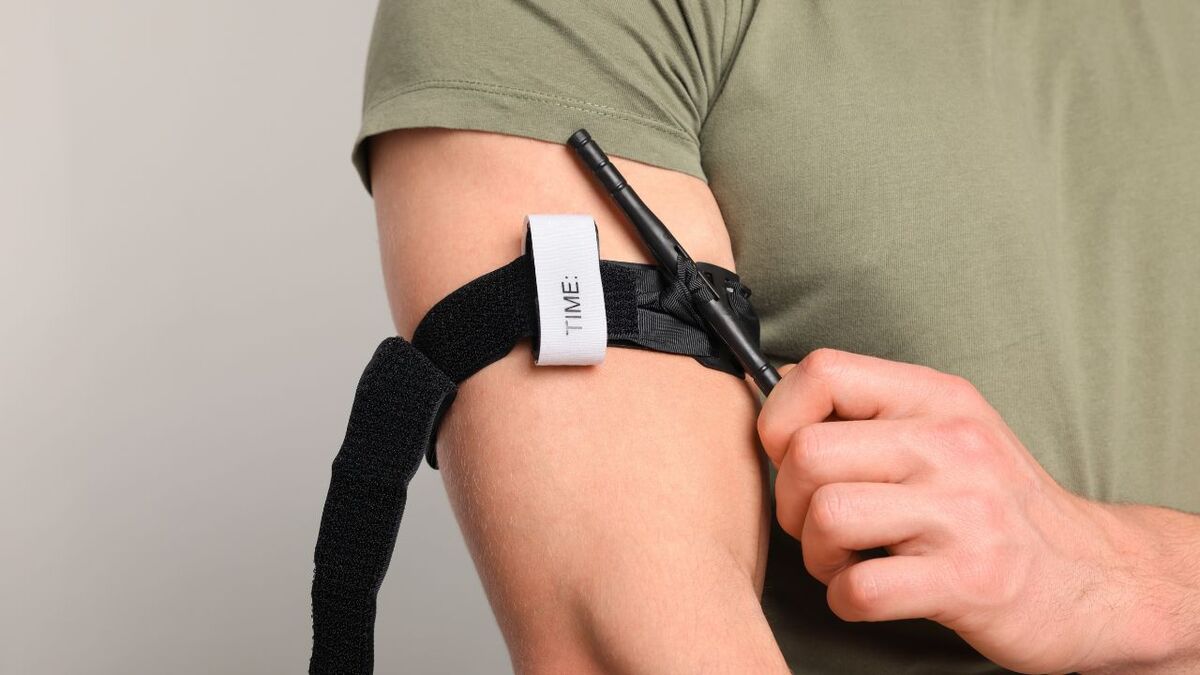
Tourniquet
Nomen
Meaning
A tourniquet is a device used to control severe bleeding by applying pressure to a limb. In the context of survival, bushcraft, wilderness, camping, and hiking, a tourniquet is an essential tool for emergency medical situations. It can be used to stop arterial bleeding and prevent life-threatening blood loss. Tourniquets are lightweight, compact, and easy to carry, making them a crucial item in any outdoor first aid kit. Knowing how to properly apply a tourniquet and when to use it can mean the difference between life and death in remote or challenging environments.

Examples
„I was out in the wilderness when I accidentally cut my leg with my knife. I quickly grabbed my tourniquet and applied it tightly above the wound to stop the bleeding.“
„During a survival training, my friend fell from a tree and injured his arm. I immediately reached for my tourniquet and secured it around his upper arm to control the bleeding.“
„While hiking with my group, one of our members got bitten by a venomous snake. We used a tourniquet to restrict the blood flow and slow down the spread of the venom until we could get medical help.“
„In a bushcraft workshop, we learned how to make improvised tourniquets using strips of cloth and sticks. It's a valuable skill to have in case of emergencies when a proper tourniquet is not available.“
„As a survival expert, I always carry a tourniquet in my backpack. It's a crucial tool that can save lives in situations where severe bleeding occurs.“
Origin
The word "tourniquet" has its origins in the French language. It comes from the French word "tourner," which means "to turn." The word "tourniquet" itself refers to a device used to stop bleeding by applying pressure and restricting blood flow.
The use of tourniquets can be traced back to ancient times, where they were used in various forms to control bleeding during medical procedures and surgeries. The concept of using a device to constrict blood vessels and stop bleeding has been practiced for centuries.
Over time, tourniquets have evolved and become more advanced in their design and functionality. In modern medicine and emergency situations, tourniquets are commonly used to control severe bleeding, especially in situations where direct pressure or other methods are ineffective.
Tourniquets have also found their place in the field of wilderness survival and first aid. They are considered an essential tool in emergency situations where medical help may not be readily available. Knowing how to properly apply a tourniquet can be life-saving in situations where severe bleeding cannot be controlled by other means.
Overall, the word "tourniquet" has its roots in the French language and has evolved over time to become a crucial tool in medical and survival contexts.
Synonyms
Tourniquet, Compression bandage, Pressure bandage, Emergency bandage, Trauma bandage, Blood stopper, Arterial tourniquet, Limb tourniquet
Antonyms
Loose, Release, Untie, Unfasten, Unbind, Undo, Unclasp, Unstrap
Relatives
First Aid, Emergency, Bleeding, Trauma, Medical, Hemorrhage, Pressure, Stop
Historical and cultural importance
A tourniquet is a device used to control severe bleeding by applying pressure to a limb or extremity. Its historical and cultural relevance can be traced back to ancient times, where it was used in various forms to stop bleeding and save lives.
In ancient Greece, tourniquets were made from materials such as leather straps or ropes and were used by military medics to treat wounded soldiers on the battlefield. The Roman army also utilized tourniquets during their conquests, recognizing their effectiveness in preventing excessive blood loss.
During the Middle Ages, tourniquets were commonly used by surgeons and barbers in their medical practices. They were often made from strips of cloth or leather and tightened with a stick or rod. These makeshift tourniquets were essential in controlling bleeding during surgeries and amputations.
In more recent history, tourniquets gained significant attention during World War I and World War II. Medical advancements led to the development of more efficient and adjustable tourniquets, which were widely used to treat soldiers with severe injuries on the battlefield.
Today, tourniquets are an essential tool in first aid and emergency medical kits. They are used by paramedics, military personnel, and outdoor enthusiasts to quickly control life-threatening bleeding until further medical assistance can be provided.
The historical and cultural significance of tourniquets highlights their importance in saving lives and preventing excessive blood loss, making them a crucial tool in survival situations.
More information about the term Tourniquet
Tourniquet: A Lifesaving Tool in Emergency Situations
A tourniquet is a crucial tool that can save lives in emergency situations. It is a device used to control severe bleeding by applying pressure to a limb, thereby stopping the flow of blood. In survival scenarios, where medical help may not be readily available, knowing how to use a tourniquet properly can be a life-saving skill.
When to Use a Tourniquet
A tourniquet should only be used in situations where there is severe bleeding that cannot be controlled by direct pressure or other means. This includes arterial bleeding, where blood is spurting or gushing out, or when bleeding continues despite applying pressure. It is important to note that a tourniquet should be used as a last resort, as it can cause damage to the limb if left in place for an extended period.
How to Apply a Tourniquet
When applying a tourniquet, follow these steps:
- Identify the source of bleeding and ensure your own safety.
- Place the tourniquet around the limb, between the wound and the heart.
- Tighten the tourniquet until the bleeding stops. You should aim to completely stop the blood flow, but avoid overtightening.
- Secure the tourniquet in place using the provided mechanisms, such as buckles or Velcro straps.
- Make a note of the time the tourniquet was applied. This information is crucial for medical professionals.
Monitoring and Seeking Medical Help
Once the tourniquet is applied, it is important to monitor the injured person closely. Check for any signs of circulation loss, such as numbness, tingling, or pale skin. If possible, try to elevate the injured limb to reduce swelling. It is crucial to seek medical help as soon as possible, as a tourniquet should not be left in place for an extended period.
Tourniquet Maintenance and Training
Regularly check your tourniquet for any signs of wear or damage, and replace it if necessary. It is also important to practice using a tourniquet before an emergency situation arises. Familiarize yourself with the specific tourniquet you own and ensure you know how to apply it correctly. Taking a first aid or wilderness survival course can provide you with the necessary training and knowledge to effectively use a tourniquet.
Remember, a tourniquet is a powerful tool that can save lives, but it should only be used in extreme situations where other methods of bleeding control have failed. Proper training and understanding of when and how to use a tourniquet are essential for its effective application.
Back to overview

